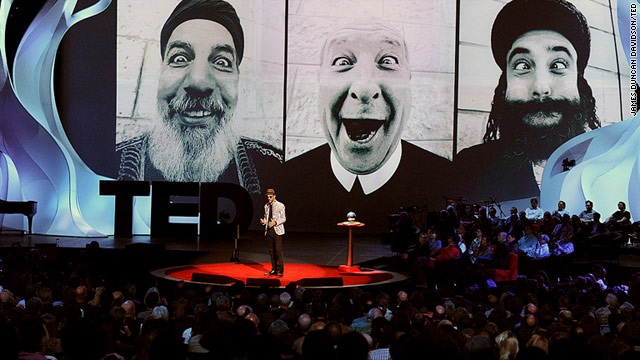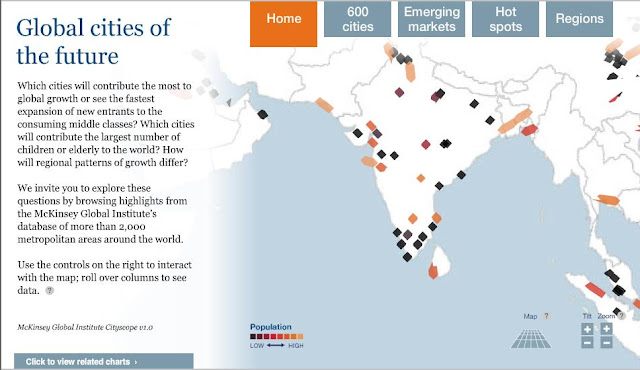15 reasons for wonder
-------------------------------------------------------------------------------------------------
Long Beach, California (CNN) -- Can something be in two places at once? Can you make a hamburger without harming a cow? Can one man conduct a chorus of 2,000 voices scattered in dozens of countries around the world? And can art change the world?
The answer to all four questions is yes, as speakers demonstrated in the opening days of this year's TED conference, the premier annual event organized by TED, a nonprofit whose tagline is "Ideas worth spreading."
Grouped under the theme "The Rediscovery of Wonder," speakers whose expertise ranged from the world of physics to the business of restaurants told an audience of nearly 2,000 about the ideas that animate their work. Many of them work at the leading edge of their fields, using their intelligence, massive computing technology and the wisdom of the crowd to ignite ideas that inspire wonder on many levels. (TED has a partnership with CNN in which talks from its conferences are published weekly on CNN.com.)
In the final session Wednesday, streamed over the Web, anonymous street artist JR concealed his features with hat and sunglasses but laid open his plan for a radical worldwide art project to change perceptions.
JR was awarded the 2011 TED Prize: $100,000 and a wish granted to him. The 27-year-old, who began his work as a teenage graffiti artist in Paris, said, "I wish for you to stand up for what you care about by participating in a global art project."
He unveiled a website (http://www.insideoutproject.net/) to which people can submit portraits they would like to see printed as giant posters suitable for display in their home cities.
JR has masterminded art projects around the world, pasting up posters on the street to change perceptions of the world. In Face 2 Face, a project in the Middle East, his team posed Israelis and Palestinians who have the same occupations -- lawyers and cabdrivers, for example -- and got them to make faces. The posters have been displayed on both sides of the wall separating Israeli and Palestinian populations. He says most people couldn't tell which were Israeli and which were Palestinian.
An interview with JR
JR's talk put him in the company of other speakers describing leading-edge projects:
A nonviolent revolution that toppled dictatorships: Speakers Wael Ghonim, who helped create the uprising that toppled Egypt's Hosni Mubarak, and Wadah Khanfar, the Al-Jazeera network's director-general, gave separate talks on the extraordinary upheaval in the Arab world. "The future we dreamed of has arrived in the Middle East," said Khanfar, crediting a new generation that seeks a better life without subscribing to outworn ideology. In a speech taped in Cairo, Ghonim, a Google executive on leave, described how a largely leaderless movement used technology to unite and achieve things that would have been considered impossible only months earlier. In the process, he discovered, "the power of the people is much stronger than the people in power."
A hamburger that bleeds, a cow that doesn't: Chef Homaru Cantu, of Moto Restaurant in Chicago, created a hamburger made of three ingredients cows find delicious: beets, barley and corn. The bleeding hamburger didn't require slaughtering a cow, with all the environmental damage that entails. "We've taken the cow out of the equation," he says. His team is experimenting with replacing threatened tuna with a specially seasoned and prepared form of watermelon. And perhaps most wondrous -- or scary -- of all, Cantu has created a Cuban pork sandwich in the shape of a realistic-looking Cuban cigar, served in a $1.99 ashtray.
Puppets that breathe: South African puppeteers Basil Jones and Adrian Kohler, of the Handspring Puppet Company, demonstrated how they brought realistic-seeming breath and other lifelike qualities to puppets, such as a horse that will be used with human riders in "War Horse," a play about to open in New York.
Things that can be in two places at once: Physicist Aaron O'Connell explained how he created a demonstration of a phenomenon in quantum mechanics that enables microscopic particles to be in two places at once. O'Connell built a small diving board-shaped object, mostly out of aluminum, and put it in a dark vacuum at a temperature just above absolute zero. The result: a visible object that could rotate and not rotate at the same time.
The ink cartridge that traveled the continent, twice: Carlo Ratti, who heads MIT's Sense-able City Lab, put sensors on trash in Seattle and discovered where things people discard wind up. Many objects were disposed of locally; electronic products seemed to follow a long and sometimes tortuous path -- for example, an ink cartridge made its way to the East Coast before winding up in Baja California.
A virtual, worldwide chorus: Composer and conductor Eric Whitacre showed how he selected and conducted singers for a chorus composed of people who have never been in the same room but whose voices blend together into a harmonious and at times otherworldly video. His first such video, "Lux Aurumque," with 185 voices, went viral, and he's working on another ("Sleep") with more than 2,000 voices.
From "gaga" to "water": Deb Roy, a scientist at MIT's Media Lab, installed cameras throughout his home to track the development of his infant son and family. More than five years later, he has 90,000 hours of video showing child development in extraordinary detail, including how his son learned and perfected pronunciation of the word "water," which he first pronounced "gaga" as a 1-year-old. In a "wow"-inducing video that ended his talk with a standing ovation, Roy is seen with his son as the camera captures his first series of extended steps.
Why doodling is vital: Sunni Brown made the case that doodling, far from being a waste of time, is an essential method of processing information that can lead to inventing new ideas and products. Tell that to your seventh-grade teacher.
A car executive who doesn't want to sell too many cars: Bill Ford, great-grandson of auto industry pioneer Henry Ford and executive chairman of Ford Motor Co., says he was warned when he joined the company in the 1970s not to "associate with known or suspected environmentalists." Ford has sought to put his company on a path toward reducing environmentally harmful emissions and now is focusing attention on the dangers presented by a world in which the number of cars could grow from 800 million to as many as 4 billion. He called for ideas to cope with rising congestion that could choke mobility. One idea: a smart network in which cars "talk" to each other. "A green traffic jam is still a traffic jam," Ford said.
A YouTube revolution in education: Salman Khan, a hedge fund analyst, used lessons he created on YouTube when he was based in Boston to tutor his cousins in New Orleans in math. Today, more than a million unique users a month go to the Khan Academy for chalkboard-style lessons narrated by Khan. He gave up hedge funds to run his nonprofit, which has created software that teachers can use to track students and help them master subjects on an individual basis. "You just got a glimpse of the future of education," said Bill Gates, who picked Khan as one of four speakers for a session he curated.
A devastating disease the world could eradicate: Epidemiologist Bruce Aylward, another speaker at Gates' session, said the world has made remarkable progress against polio. Twenty years ago, the virus paralyzed 1,000 children a day; today, the toll is 99% lower. Stamping out the remaining pockets of the disease is vital; if people blink at the challenge, Aylward said, the toll could spring back to 200,000 children a year.
A nation that is making massive progress on health care, poverty and transparency: Amina Az-Zubair, a special adviser to the president of Nigeria, is using a debt relief fund that provides a billion dollars a year to invest in projects that have sharply reduced child and maternal mortality, increased educational opportunity and attacked corruption. She said Nigeria is on track to meet the Millenium Development Goals for social and economic progress by 2015.
A life form that thrives on arsenic: NASA biochemist Felisa Wolfe-Simon is studying alternative forms of life that exist on Earth and could populate the universe. Her team found a microbe in California's Mono Lake whose growth is stimulated by arsenic, a toxic element.
What makes Bobby McFerrin wonder? The 60-year-old Grammy-winning singer and conductor's answer: "Waking up every morning."



Comments
Post a Comment
If you have any doubts, please let me know